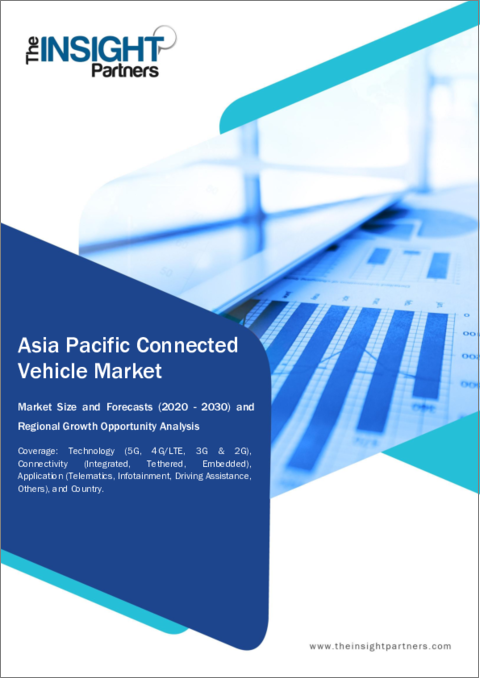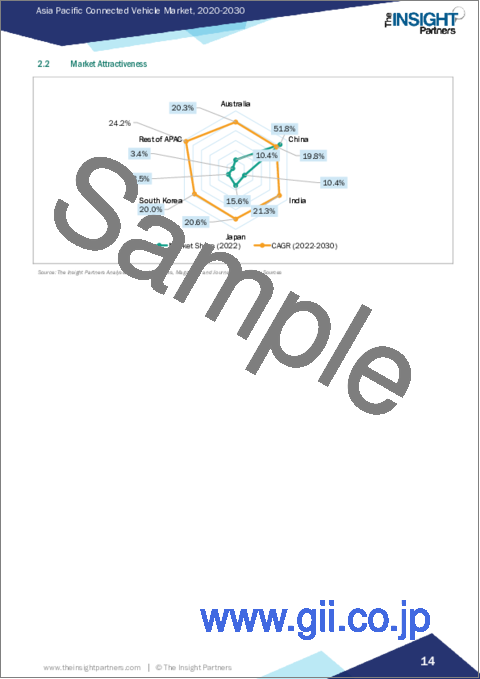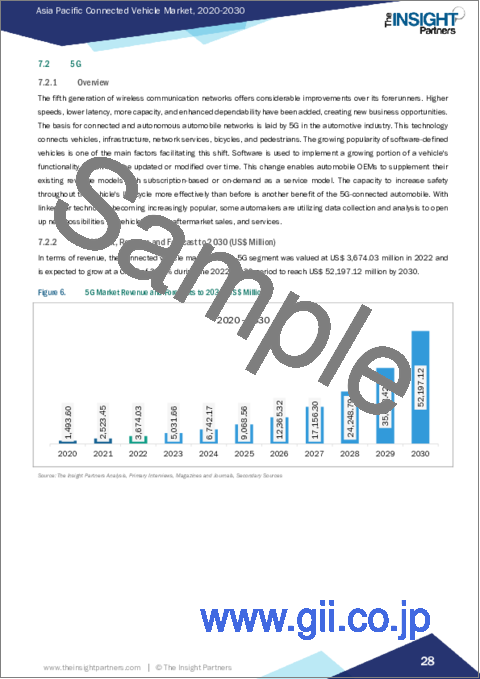|
|
市場調査レポート
商品コード
1494556
アジア太平洋地域のコネクテッド車両市場:2030年までの予測- 地域別分析- 技術、コネクティビティ、用途別Asia Pacific Connected Vehicle Market Forecast to 2030 - Regional Analysis - by Technology (5G, 4G/LTE, and 3G & 2G), Connectivity (Integrated, Tethered, and Embedded), and Application (Telematics, Infotainment, Driving Assistance, and Others) |
||||||
|
|||||||
| アジア太平洋地域のコネクテッド車両市場:2030年までの予測- 地域別分析- 技術、コネクティビティ、用途別 |
|
出版日: 2024年04月05日
発行: The Insight Partners
ページ情報: 英文 102 Pages
納期: 即納可能
|
全表示
- 概要
- 図表
- 目次
アジア太平洋地域のコネクテッド車両市場は、2022年に216億6,003万米ドルと評価され、2030年には951億9,379万米ドルに達すると予測され、2022年から2030年までのCAGRは20.3%と推定されます。
スマートシティ構想の高まりがアジア太平洋地域コネクテッド車両市場を後押し
スマートシティとインフラ開拓が今後数年間のコネクテッド車両市場の需要に与える影響は、変革的なものになるとみられます。世界中の都市がインテリジェントで技術主導の都市センターへと進化を続ける中、こうした開発とコネクテッド車両市場の相乗効果が、都市モビリティの未来を形作ることになるでしょう。革新的な都市構想が重視されるにつれ、コネクテッド車両を支えるインフラへの投資が促進されます。こうした投資は、センサー、データネットワーク、リアルタイムの交通管理システムの配備を包含し、コネクテッド車両業界に有利なデータの豊富なエコシステムを構築します。こうした取り組みは、スマートシティの全体的な発展と導入にプラスの影響を与えています。スマートシティがますます環境の持続可能性を優先するようになるにつれて、コネクテッド車両、特に電気自動車やハイブリッド・モデルの需要が急増すると予想されます。これらの都市は、排出ガスを削減し公害と闘うために、環境に優しい交通手段を積極的に推進しています。コネクテッド・カーは、エネルギー管理、遠隔診断、最適化された充電などの機能を提供することで、この取り組みにおいて極めて重要な役割を果たしており、これらはすべて、より環境に優しく持続可能な都市交通エコシステムに貢献しています。都市が環境に配慮したモビリティ・ソリューションへの奨励と投資を続けているため、環境に優しい機能を備えたコネクテッド車両の市場需要は大幅に拡大するとみられます。
アジア太平洋地域のコネクテッド車両市場概要
アジア太平洋地域は、世界で最もダイナミックで急速に発展している自動車産業の1つです。世界最大かつ最多の人口を擁するこの地域には、大手自動車メーカーから新興自動車メーカーまで、多様な自動車メーカーが存在します。この活気あるセクターの中で、コネクテッド車両産業は大きな牽引力を得ており、人々の自動車との関わり方や交通エコシステムを再構築しています。技術革新、都市化、中産階級の人口増加の融合が、アジア太平洋地域のコネクテッド車両産業を特徴づけています。トヨタ、現代自動車、比亜迪(BYD)を含むこの地域の大手自動車メーカーは、高度なコネクティビティ機能を自動車に組み込むために多額の投資を行っています。例えば、トヨタ自動車は中国のモビリティ・テクノロジー企業であるDiDi, Globalに6億米ドルを投資しました。
この地域では、エネルギー効率に優れたルーティングとインテリジェントな充電ソリューションに重点を置いた電気自動車が大幅に成長しています。中国やインドなどの主要諸国は、電気モビリティを積極的に推進し、電気自動車導入のインセンティブを提供し、充電インフラの整備を支援しています。5Gネットワークの展開を含むこの地域の強固なデジタル・インフラは、コネクテッド車両産業の成長をさらに加速させる。高速で低遅延の接続性により、車両はリアルタイムデータにアクセスし、無線アップデートを受信し、他の車両やインフラとシームレスに通信することができます。
アジア太平洋地域のコネクテッド車両市場の収益と2030年までの予測(金額)
アジア太平洋地域のコネクテッド車両市場のセグメンテーション
アジア太平洋地域のコネクテッド車両市場は、技術、接続性、用途、国によって区分されます。
技術に基づき、アジア太平洋地域のコネクテッド車両市場は5G、4G/LTE、3G &2Gに分類されます。4G/LTEセグメントは2022年に最大の市場シェアを占めました。
接続性に基づいて、アジア太平洋地域のコネクテッド車両市場は統合型、テザー型、組み込み型に区分されます。統合型セグメントが2022年に最大の市場シェアを占めました。
アジア太平洋地域のコネクテッド車両市場は、用途に基づき、テレマティクス、インフォテインメント、運転支援、その他に分類されます。2022年には、インフォテインメント・セグメントが最大の市場シェアを占めました。
国別に見ると、アジア太平洋地域のコネクテッド車両市場は、オーストラリア、中国、インド、日本、韓国、その他アジア太平洋地域に区分されます。2022年のアジア太平洋地域のコネクテッド車両市場シェアは中国が独占しました。
AT&T、Audi AG、Bayerische Motoren Werke AG、Continental AG、Denso、General Motors Co、Harman International Industries Inc、Robert Bosch GmbH、Visteon Corp、Vodafone Group Plcは、アジア太平洋地域のコネクテッド車両市場で事業を展開している主要企業です。
目次
第1章 イントロダクション
第2章 エグゼクティブサマリー
- 主要洞察
- 市場の魅力
第3章 調査手法
- 調査範囲
- 2次調査
- 1次調査
第4章 アジア太平洋地域のコネクテッド車両市場情勢
- PEST分析
- エコシステム分析
- 自動車メーカーとOEM
- ティア1サプライヤー
- ティア2およびティア3サプライヤー
- 通信プロバイダー
- 技術プロバイダー
- 政府規制および標準化団体
- データプロバイダー
- 物流・流通
- サービスおよびメンテナンス・プロバイダー
- エンドユーザー
- アフターマーケットプロバイダー
第5章 アジア太平洋地域のコネクテッド車両市場- 主要産業力学
- コネクテッド車両市場- 主要産業力学
- 市場促進要因
- 運転支援システムに対する需要の高まり
- コネクティビティ技術の進歩
- 市場抑制要因
- データプライバシーとセキュリティに関する懸念
- 高い初期費用と手頃な価格への懸念
- 市場機会
- スマートシティ構想の増加
- 自律走行車の採用
- 今後の動向
- コネクテッド車両のデータ収益化
- 促進要因と抑制要因の影響
第6章 アジア太平洋地域のコネクテッド車両市場:国別市場分析
- コネクテッド車両市場の収益、2022年~2030年
- コネクテッド車両市場の予測と分析
第7章 アジア太平洋地域のコネクテッド車両市場分析:技術別
- コネクテッド車両市場:技術別(2022年、2030年)
- 5G
- 4G
- 3G・2G
第8章 アジア太平洋地域のコネクテッド車両市場分析:コネクティビティ別
- コネクテッド車両市場:コネクティビティ別(2022年、2030年)
- 統合型
- テザリング
- 組み込み型
第9章 アジア太平洋地域のコネクテッド車両市場分析:用途別
- コネクテッド車両市場:用途別(2022年、2030年)
- テレマティクス
- インフォテインメント
- 運転支援
- その他
第10章 アジア太平洋地域のコネクテッド車両市場:国別分析
- アジア太平洋地域
- オーストラリア
- 中国
- インド
- 日本
- 韓国
- その他アジア太平洋地域
第11章 業界情勢
- 市場イニシアティブ
- 新製品開発
- 合併と買収
第12章 企業プロファイル
- Harman International Industries Inc
- Robert Bosch GmbH
- AT&T Inc
- Denso Corp
- Visteon Corp
- Continental AG
- Audi AG
- General Motors Co
- Bayerische Motoren Werke AG
- Vodafone Group Plc
第13章 付録
List Of Tables
- Table 1. Connected Vehicle Market Revenue and Forecasts To 2030 (US$ Million)
- Table 2. Connected Vehicle Market Revenue and Forecasts To 2030 (US$ Million) - Technology
- Table 3. Connected Vehicle Market Revenue and Forecasts To 2030 (US$ Million) - Connectivity
- Table 4. Connected Vehicle Market Revenue and Forecasts To 2030 (US$ Million) - Application
- Table 5. Australia Connected Vehicle Market Revenue and Forecast to 2030 (US$ Mn) - Technology
- Table 6. Australia Connected Vehicle Market Revenue and Forecast to 2030 (US$ Mn) - Connectivity
- Table 7. Australia Connected Vehicle Market Revenue and Forecast to 2030 (US$ Mn) - Application
- Table 8. China Connected Vehicle Market Revenue and Forecast to 2030 (US$ Mn) - Technology
- Table 9. China Connected Vehicle Market Revenue and Forecast to 2030 (US$ Mn) - Connectivity
- Table 10. China Connected Vehicle Market Revenue and Forecast to 2030 (US$ Mn) - Application
- Table 11. India Connected Vehicle Market Revenue and Forecast to 2030 (US$ Mn) - Technology
- Table 12. India Connected Vehicle Market Revenue and Forecast to 2030 (US$ Mn) - Connectivity
- Table 13. India Connected Vehicle Market Revenue and Forecast to 2030 (US$ Mn) - Application
- Table 14. Japan Connected Vehicle Market Revenue and Forecast to 2030 (US$ Mn) - Technology
- Table 15. Japan Connected Vehicle Market Revenue and Forecast to 2030 (US$ Mn) - Connectivity
- Table 16. Japan Connected Vehicle Market Revenue and Forecast to 2030 (US$ Mn) - Application
- Table 17. South Korea Connected Vehicle Market Revenue and Forecast to 2030 (US$ Mn) - Technology
- Table 18. South Korea Connected Vehicle Market Revenue and Forecast to 2030 (US$ Mn) - Connectivity
- Table 19. South Korea Connected Vehicle Market Revenue and Forecast to 2030 (US$ Mn) - Application
- Table 20. Rest of Asia Pacific Connected Vehicle Market Revenue and Forecast to 2030 (US$ Mn) - Technology
- Table 21. Rest of Asia Pacific Connected Vehicle Market Revenue and Forecast to 2030 (US$ Mn) - Connectivity
- Table 22. Rest of Asia Pacific Connected Vehicle Market Revenue and Forecast to 2030 (US$ Mn) - Application
List Of Figures
- Figure 1. Connected Vehicle Market Segmentation, By Country
- Figure 2. PEST Analysis
- Figure 3. Ecosystem: Connected Vehicle Market
- Figure 4. Impact Analysis of Drivers and Restraints
- Figure 5. Connected Vehicle Market Revenue (US$ Million), 2022 - 2030
- Figure 6. Connected Vehicle Market Share (%) - Technology, 2022 and 2030
- Figure 7. 5G Market Revenue and Forecasts To 2030 (US$ Million)
- Figure 8. 4G Market Revenue and Forecasts To 2030 (US$ Million)
- Figure 9. 3G & 2G Market Revenue and Forecasts To 2030 (US$ Million)
- Figure 10. Connected Vehicle Market Share (%) - Connectivity, 2022 and 2030
- Figure 11. Integrated Market Revenue and Forecasts To 2030 (US$ Million)
- Figure 12. Tethered Market Revenue and Forecasts To 2030 (US$ Million)
- Figure 13. Embedded Market Revenue and Forecasts To 2030 (US$ Million)
- Figure 14. Connected Vehicle Market Share (%) - Application, 2022 and 2030
- Figure 15. Telematics Market Revenue and Forecasts To 2030 (US$ Million)
- Figure 16. Infotainment Market Revenue and Forecasts To 2030 (US$ Million)
- Figure 17. Driving assistance Market Revenue and Forecast to 2030 (US$ Million)
- Figure 18. Others Market Revenue and Forecast to 2030 (US$ Million)
- Figure 19. Asia Pacific Connected Vehicle Market Revenue, by Key Country, (2022) (US$ Million)
- Figure 20. Connected Vehicle Market Breakdown by Key Country, 2022 and 2030 (%)
- Figure 21. Australia Connected Vehicle Market Revenue and Forecast to 2030 (US$ Mn)
- Figure 22. China Connected Vehicle Market Revenue and Forecast to 2030 (US$ Mn)
- Figure 23. India Connected Vehicle Market Revenue and Forecast to 2030 (US$ Mn)
- Figure 24. Japan Connected Vehicle Market Revenue and Forecast to 2030 (US$ Mn)
- Figure 25. South Korea Connected Vehicle Market Revenue and Forecast to 2030 (US$ Mn)
- Figure 26. Rest of Asia Pacific Connected Vehicle Market Revenue and Forecast to 2030 (US$ Mn)
The Asia Pacific connected vehicle market was valued at US$ 21,660.03 million in 2022 and is expected to reach US$ 95,193.79 million by 2030; it is estimated to register a CAGR of 20.3% from 2022 to 2030.
Increasing Smart City Initiatives Fuel Asia Pacific Connected Vehicle Market
The impact of smart cities and infrastructure development on the demand for the connected vehicle market in the coming years is poised to be transformative. As cities across the globe continue to evolve into intelligent, tech-driven urban centers, the synergy between these developments and the connected vehicle market is set to shape the future of urban mobility. The growing emphasis on innovative city initiatives drives investments in infrastructure supporting connected vehicles. These investments encompass the deployment of sensors, data networks, and real-time traffic management systems that create a rich ecosystem of data that is favorable for the connected vehicles industry. Such initiatives are positively impacting the overall development and adoption of smart cities. As smart cities increasingly prioritize environmental sustainability, the demand for connected vehicles, particularly electric and hybrid models, is expected to surge. These cities actively promote eco-friendly transportation options to reduce emissions and combat pollution. Connected vehicles play a pivotal role in this endeavor by offering features such as energy management, remote diagnostics, and optimized charging, all of which contribute to a greener, more sustainable urban transportation ecosystem. As cities continue to incentivize and invest in green mobility solutions, the market demand for connected vehicles with environmentally friendly features is set to grow substantially.
Asia Pacific Connected Vehicle Market Overview
Asia Pacific is home to one of the most dynamic and rapidly evolving automotive industries in the world. As the world's largest and most populous region, it encompasses a diverse landscape of automotive manufacturers, from established giants to emerging players. Within this vibrant sector, the connected vehicle industry is gaining significant traction and reshaping the way people interact with their vehicles and the transportation ecosystem. A blend of innovation, urbanization, and a growing middle-class population characterizes the connected vehicle industry in Asia Pacific. Leading automakers across the region, including Toyota, Hyundai, and BYD, are investing heavily in integrating advanced connectivity features into their vehicles. For instance, Toyota Corporation invested US$ 600 million in China's mobility technology company, DiDi, Global.
The region is witnessing substantial growth in electric-connected vehicles, with a focus on energy-efficient routing and intelligent charging solutions. Major countries such as China and India are actively promoting electric mobility, providing incentives for electric vehicle adoption, and supporting the development of charging infrastructure. The robust digital infrastructure in the region, including the deployment of 5G networks, further accelerates the growth of the connected vehicle industry. With high-speed, low-latency connectivity, vehicles can access real-time data, receive over-the-air updates, and communicate seamlessly with other vehicles and infrastructure.
Asia Pacific Connected Vehicle Market Revenue and Forecast to 2030 (US$ Million)
Asia Pacific Connected Vehicle Market Segmentation
The Asia pacific connected vehicle market is segmented based on technology, connectivity, application, and country.
Based on technology, the Asia pacific connected vehicle market is categorized into 5G, 4G/LTE, and 3G & 2G. The 4G/LTE segment held the largest market share in 2022.
Based on connectivity, the Asia pacific connected vehicle market is segmented into integrated, tethered, and embedded. The integrated segment held the largest market share in 2022.
Based on application the Asia pacific connected vehicle market is categorized into telematics, infotainment, driving assistance, and others. The infotainment segment held the largest market share in 2022.
Based on country, the Asia pacific connected vehicle market is segmented into Australia, China, India, Japan, South Korea, and the Rest of Asia pacific. China dominated the Asia pacific connected vehicle market share in 2022.
AT&T, Audi AG, Bayerische Motoren Werke AG, Continental AG, Denso, General Motors Co, Harman International Industries Inc, Robert Bosch GmbH, Visteon Corp, and Vodafone Group Plc are among the leading companies operating in the Asia pacific connected vehicle market.
Table Of Contents
1. Introduction
- 1.1 The Insight Partners Research Report Guidance
- 1.2 Market Segmentation
2. Executive Summary
- 2.1 Key Insights
- 2.2 Market Attractiveness
3. Research Methodology
- 3.1 Coverage
- 3.2 Secondary Research
- 3.3 Primary Research
4. Asia Pacific Connected Vehicle Market Landscape
- 4.1 Overview
- 4.2 PEST Analysis
- 4.3 Ecosystem Analysis
- 4.3.1 Automakers and OEMs
- 4.3.2 Tier 1 Suppliers
- 4.3.3 Tier 2 and Tier 3 Suppliers
- 4.3.4 Telecommunications Providers
- 4.3.5 Technology Providers
- 4.3.6 Government Regulations and Standards Bodies
- 4.3.7 Data Providers
- 4.3.8 Logistics and Distribution
- 4.3.9 Service and Maintenance Providers
- 4.3.10 End Users
- 4.3.11 Aftermarket Providers
5. Asia Pacific Connected Vehicle Market - Key Industry Dynamics
- 5.1 Connected Vehicle Market - Key Industry Dynamics
- 5.2 Market Drivers
- 5.2.1 Growing demand for driving assistance system
- 5.2.2 Advancements in Connectivity Technology
- 5.3 Market Restraints
- 5.3.1 Data Privacy and Security Concerns
- 5.3.2 High Initial Costs and Affordability Concerns
- 5.4 Market Opportunities
- 5.4.1 Increasing smart city initiatives
- 5.4.2 Adoption of Autonomous vehicles
- 5.5 Future Trends
- 5.5.1 Connected Car Data Monetization
- 5.6 Impact of Drivers and Restraints:
6. Asia Pacific Connected Vehicle Market - Country Market Analysis
- 6.1 Connected Vehicle Market Revenue (US$ Million), 2022 - 2030
- 6.2 Connected Vehicle Market Forecast and Analysis
7. Asia Pacific Connected Vehicle Market Analysis - Technology
- 7.1 Connected Vehicle Market, By Technology (2022 and 2030)
- 7.2 5G
- 7.2.1 Overview
- 7.2.2 5G Market, Revenue and Forecast to 2030 (US$ Million)
- 7.3 4G
- 7.3.1 Overview
- 7.3.2 4G Market, Revenue and Forecast to 2030 (US$ Million)
- 7.4 3G & 2G
- 7.4.1 Overview
- 7.4.2 3G & 2G Market, Revenue and Forecast to 2030 (US$ Million)
8. Asia Pacific Connected Vehicle Market Analysis - Connectivity
- 8.1 Connected Vehicle Market, By Connectivity (2022 and 2030)
- 8.2 Integrated
- 8.2.1 Overview
- 8.2.2 Integrated Market, Revenue and Forecast to 2030 (US$ Million)
- 8.3 Tethered
- 8.3.1 Overview
- 8.3.2 Tethered Market, Revenue and Forecast to 2030 (US$ Million)
- 8.4 Embedded
- 8.4.1 Overview
- 8.4.2 Embedded Market, Revenue and Forecast to 2030 (US$ Million)
9. Asia Pacific Connected Vehicle Market Analysis - Application
- 9.1 Connected Vehicle Market, By Application (2022 and 2030)
- 9.2 Telematics
- 9.2.1 Overview
- 9.2.2 Telematics Market, Revenue and Forecast to 2030 (US$ Million)
- 9.3 Infotainment
- 9.3.1 Overview
- 9.3.2 Infotainment Market, Revenue and Forecast to 2030 (US$ Million)
- 9.4 Driving assistance
- 9.4.1 Overview
- 9.4.2 Driving assistance Market, Revenue and Forecast to 2030 (US$ Million)
- 9.5 Others
- 9.5.1 Overview
- 9.5.2 Others Market, Revenue and 2022-2030 to 2030 (US$ Million)
10. Asia Pacific Connected Vehicle Market - Country Analysis
- 10.1 Asia Pacific
- 10.1.1 Overview
- 10.1.2 Asia Pacific Connected Vehicle Market Revenue and Forecast to 2030 - By Country
- 10.1.2.1 Australia Connected Vehicle Market Revenue and Forecast to 2030 (US$ Mn)
- 10.1.2.1.1 Australia Connected Vehicle Market Breakdown by Technology
- 10.1.2.1.2 Australia Connected Vehicle Market Breakdown by Connectivity
- 10.1.2.1.3 Australia Connected Vehicle Market Breakdown by Application
- 10.1.2.2 China Connected Vehicle Market Revenue and Forecast to 2030 (US$ Mn)
- 10.1.2.2.1 China Connected Vehicle Market Breakdown by Technology
- 10.1.2.2.2 China Connected Vehicle Market Breakdown by Connectivity
- 10.1.2.2.3 China Connected Vehicle Market Breakdown by Application
- 10.1.2.3 India Connected Vehicle Market Revenue and Forecast to 2030 (US$ Mn)
- 10.1.2.3.1 India Connected Vehicle Market Breakdown by Technology
- 10.1.2.3.2 India Connected Vehicle Market Breakdown by Connectivity
- 10.1.2.3.3 India Connected Vehicle Market Breakdown by Application
- 10.1.2.4 Japan Connected Vehicle Market Revenue and Forecast to 2030 (US$ Mn)
- 10.1.2.4.1 Japan Connected Vehicle Market Breakdown by Technology
- 10.1.2.4.2 Japan Connected Vehicle Market Breakdown by Connectivity
- 10.1.2.4.3 Japan Connected Vehicle Market Breakdown by Application
- 10.1.2.5 South Korea Connected Vehicle Market Revenue and Forecast to 2030 (US$ Mn)
- 10.1.2.5.1 South Korea Connected Vehicle Market Breakdown by Technology
- 10.1.2.5.2 South Korea Connected Vehicle Market Breakdown by Connectivity
- 10.1.2.5.3 South Korea Connected Vehicle Market Breakdown by Application
- 10.1.2.6 Rest of Asia Pacific Connected Vehicle Market Revenue and Forecast to 2030 (US$ Mn)
- 10.1.2.6.1 Rest of Asia Pacific Connected Vehicle Market Breakdown by Technology
- 10.1.2.6.2 Rest of Asia Pacific Connected Vehicle Market Breakdown by Connectivity
- 10.1.2.6.3 Rest of Asia Pacific Connected Vehicle Market Breakdown by Application
- 10.1.2.1 Australia Connected Vehicle Market Revenue and Forecast to 2030 (US$ Mn)
11. Industry Landscape
- 11.1 Overview
- 11.2 Market Initiative
- 11.3 New Product Development
- 11.4 Merger and Acquisition
12. Company Profiles
- 12.1 Harman International Industries Inc
- 12.1.1 Key Facts
- 12.1.2 Business Description
- 12.1.3 Products and Services
- 12.1.4 Financial Overview
- 12.1.5 SWOT Analysis
- 12.1.6 Key Developments
- 12.2 Robert Bosch GmbH
- 12.2.1 Key Facts
- 12.2.2 Business Description
- 12.2.3 Products and Services
- 12.2.4 Financial Overview
- 12.2.5 SWOT Analysis
- 12.2.6 Key Developments
- 12.3 AT&T Inc
- 12.3.1 Key Facts
- 12.3.2 Business Description
- 12.3.3 Products and Services
- 12.3.4 Financial Overview
- 12.3.5 SWOT Analysis
- 12.3.6 Key Developments
- 12.4 Denso Corp
- 12.4.1 Key Facts
- 12.4.2 Business Description
- 12.4.3 Products and Services
- 12.4.4 Financial Overview
- 12.4.5 SWOT Analysis
- 12.4.6 Key Developments
- 12.5 Visteon Corp
- 12.5.1 Key Facts
- 12.5.2 Business Description
- 12.5.3 Products and Services
- 12.5.4 Financial Overview
- 12.5.5 SWOT Analysis
- 12.5.6 Key Developments
- 12.6 Continental AG
- 12.6.1 Key Facts
- 12.6.2 Business Description
- 12.6.3 Products and Services
- 12.6.4 Financial Overview
- 12.6.5 SWOT Analysis
- 12.6.6 Key Developments
- 12.7 Audi AG
- 12.7.1 Key Facts
- 12.7.2 Business Description
- 12.7.3 Products and Services
- 12.7.4 Financial Overview
- 12.7.5 SWOT Analysis
- 12.7.6 Key Developments
- 12.8 General Motors Co
- 12.8.1 Key Facts
- 12.8.2 Business Description
- 12.8.3 Products and Services
- 12.8.4 Financial Overview
- 12.8.5 SWOT Analysis
- 12.8.6 Key Developments
- 12.9 Bayerische Motoren Werke AG
- 12.9.1 Key Facts
- 12.9.2 Business Description
- 12.9.3 Products and Services
- 12.9.4 Financial Overview
- 12.9.5 SWOT Analysis
- 12.9.6 Key Developments
- 12.10 Vodafone Group Plc
- 12.10.1 Key Facts
- 12.10.2 Business Description
- 12.10.3 Products and Services
- 12.10.4 Financial Overview
- 12.10.5 Key Developments
13. Appendix
- 13.1 About The Insight Partners





